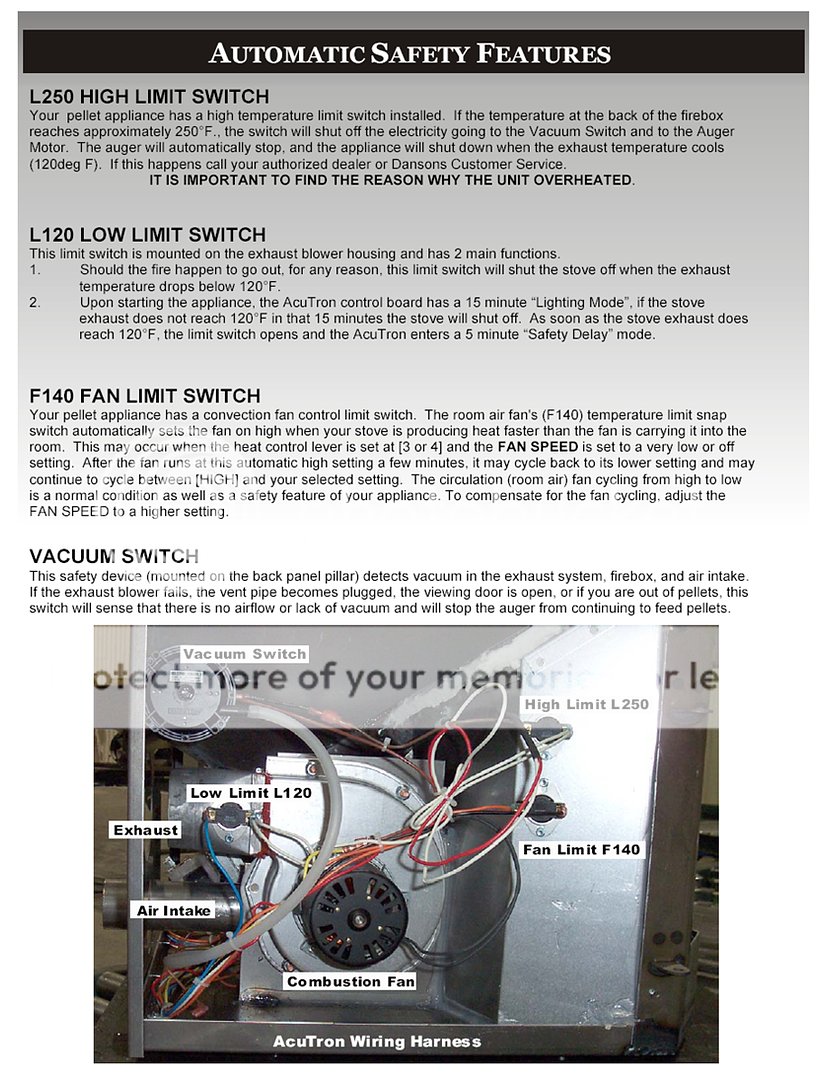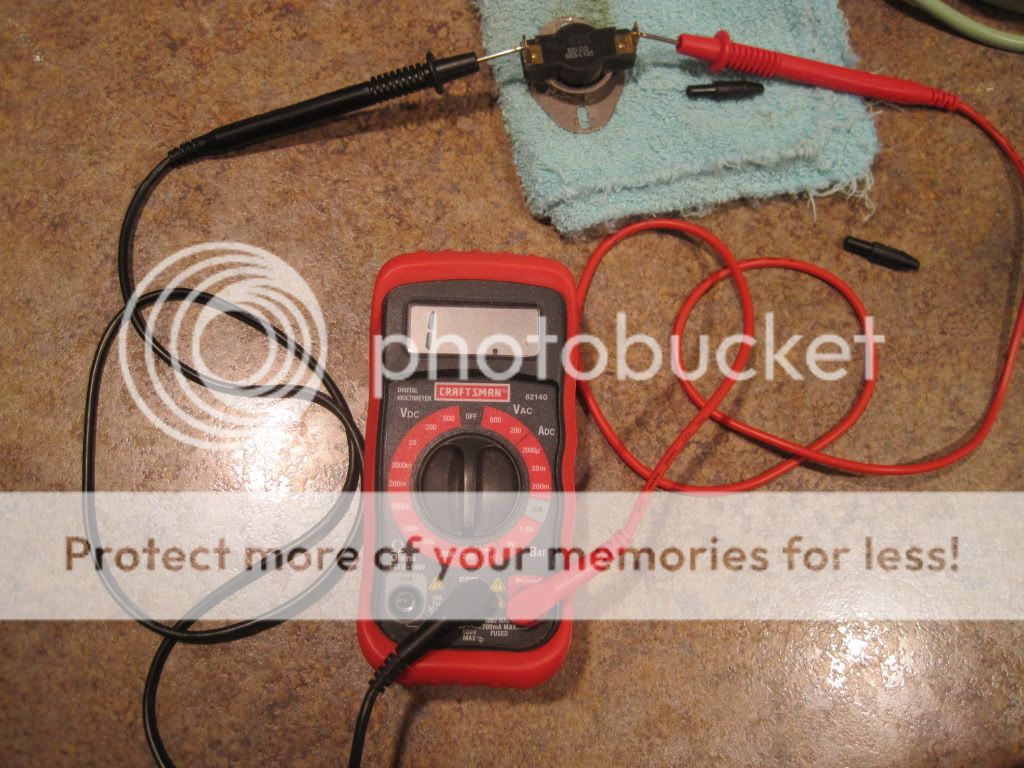Stove not shutting off
- Thread starter DemonGT
- Start date
-
Active since 1995, Hearth.com is THE place on the internet for free information and advice about wood stoves, pellet stoves and other energy saving equipment.
We strive to provide opinions, articles, discussions and history related to Hearth Products and in a more general sense, energy issues.
We promote the EFFICIENT, RESPONSIBLE, CLEAN and SAFE use of all fuels, whether renewable or fossil.
You are using an out of date browser. It may not display this or other websites correctly.
You should upgrade or use an alternative browser.
You should upgrade or use an alternative browser.
- Status
- Not open for further replies.
Bob Sorjanen
Member
can you bypass the low limit switch? if you do and it shuts down then I would think it points to that
SmokeyTheBear
Minister of Fire
can you bypass the low limit switch? if you do and it shuts down then I would think it points to that
Better off to pull it and check it with an ohm meter. Remember stove off and unplugged. The low limit should read open as in maximum resistance when disconnected from the stove's wiring.
ETA: There are a couple of switches on those units so check your wiring diagram and exploded parts diagram.
You said fans, as in both of them?Pushed the off button and the fire went out as usual but the fans keep running? i opened the door and its cold inside? I figure its a bad low limit switch? Just wanted some opinions before spending the money on one.
SmokeyTheBear
Minister of Fire
In the case of testing the low limit for shutting off you have to use an ohm meter, you can not use a jumper.
A jumper is only good for lying to the control board by telling it a switch is closed it is useless for any other purpose.
A jumper is only good for lying to the control board by telling it a switch is closed it is useless for any other purpose.
wil lanfear
Feeling the Heat
I found this for you, toll free number, doesn't cost a dime to explain the situation asking for their thoughts.
http://search.yahoo.com/r/_ylt=A0oG...lpro-Owners-Manual-DHC-Control-Multi-Fuel.pdf
http://search.yahoo.com/r/_ylt=A0oG...lpro-Owners-Manual-DHC-Control-Multi-Fuel.pdf
heat seeker
Minister of Fire
Set it on 200 in the Ω (ohms) area, and touch one lead to each terminal of the switch. If the low limit switch is good, your meter will read something like OL. If the switch is shorted closed, the meter will read some low number, perhaps 10 or 20 or less. OL means the switch is open, as it should be with a cold stove.
The leads go in the "com" and "V-Ω-mA" jacks. The switch should be disconnected when you test it.
You are testing for continuity with this setup.
ETA: you could also put the meter on the speaker symbol. That way, if the switch is closed, the meter will beep, if the switch is open, no beep.
The leads go in the "com" and "V-Ω-mA" jacks. The switch should be disconnected when you test it.
You are testing for continuity with this setup.
ETA: you could also put the meter on the speaker symbol. That way, if the switch is closed, the meter will beep, if the switch is open, no beep.
SmokeyTheBear
Minister of Fire
Make certain you disconnect the leads on one of the switches terminals, stove off and unplugged, never do a ohm reading with the device in circuit.
After reading the manual I think I understand why both fans would be on if the low limit failed in the closed position. The manual also states the fans" will run for 30 minutes after the exhaust has cooled properly".With an OAK it could be cold in the stove if it runs for 30 minutes after the low limit has opened. Do the fans eventually turn off or do they stay running indefinately?
SmokeyTheBear
Minister of Fire
The information provided above says once the switch opens a 5 minute delay to fan shut off is entered.
One has to first find out if that low limit is closed or open. If it is closed you have your problem part if it is open and outside the 5 minute delay then the problem part is the control board.
One has to first find out if that low limit is closed or open. If it is closed you have your problem part if it is open and outside the 5 minute delay then the problem part is the control board.
I'm just going by what I read in the manual under trouble shooting on page 38...
http://www.pelprostoves.com/pdfs/Pelpro-Owners-Manual-Accutron-Control.pdf
http://www.pelprostoves.com/pdfs/Pelpro-Owners-Manual-Accutron-Control.pdf
SmokeyTheBear
Minister of Fire
I'm just going by what I read in the manual under trouble shooting on page 38...
http://www.pelprostoves.com/pdfs/Pelpro-Owners-Manual-Accutron-Control.pdf
Yup, provided that manual matches his stove.
SmokeyTheBear
Minister of Fire
Did you zero the meter? That is short the two probes together and adjust it until it reads 0.
ETA: We need to know if the battery in the meter is good, when the probes touch each other you should see 0 on the meter. Some units don't have an adjustment you can make to zero the unit.
ETA: We need to know if the battery in the meter is good, when the probes touch each other you should see 0 on the meter. Some units don't have an adjustment you can make to zero the unit.
pell it
Feeling the Heat
SmokeyTheBear
Minister of Fire
If the meter has a good battery in it the switch is open.
ETA: My cheap meter even tells me to change the battery, but they aren't all the same.
ETA: My cheap meter even tells me to change the battery, but they aren't all the same.
SmokeyTheBear
Minister of Fire
Ok, the batteries are fine and your switch is fine bad , that 1 was an over limit or high resistance reading or open switch reading. It appears you are looking at a control board issue.
Call Danson and see what is what for prices and availability.
pell it
Feeling the Heat
Post #4 states that the switch opens at 120 degrees. I would think that from that statement, the switch is open on rise, and should be closed (or shunted) at room temp. Feel free to flog if I am reading it wrong.
I just changed my low temp snap disc, however, it was a close on rise type for my control board.
I just changed my low temp snap disc, however, it was a close on rise type for my control board.
SmokeyTheBear
Minister of Fire
Post #4 states that the switch opens at 120 degrees. I would think that from that statement, the switch is open on rise, and should be closed (or shunted) at room temp. Feel free to flog if I am reading it wrong.
I just changed my low temp snap disc, however, it was a close on rise type for my control board.
Yes you are correct it does appear it is a open on rise unit which should have closed when it dropped below the 120 mark.
Replace the limit switch and things are likely to be fine.
Make certain that the switch you get is an open on rise unit which is the opposite of most proof of fire systems.
tjnamtiw
Minister of Fire
Since the switch is reading just one ohm when cold, it looks to me like it's ok. (I would have expected 0 ohms though. Your meter might be suspect with the numbers jumping around when the probes are touched together). I would heat the switch up on the stove or with a match and see if the resistance goes very high. Open on rise is definitely not a fail-safe method to test for proof of fire! Not much you can do about it, though.
- Status
- Not open for further replies.
Similar threads
- Replies
- 2
- Views
- 357
- Replies
- 1
- Views
- 382
- Replies
- 8
- Views
- 298
- Replies
- 5
- Views
- 791




